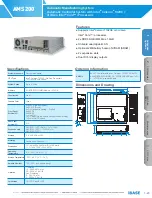
Open Plenum Array
2
Receiving
Upon receiving the product check to ensure all items
are accounted for by referencing the delivery receipt or
packing list. Inspect each crate or carton for shipping
damage before accepting delivery. Alert the carrier
of any damage detected. The customer will make
a notation of damage (or shortage of items) on the
delivery receipt and all copies of the bill of lading which
is countersigned by the delivering carrier. If damaged,
immediately contact the local sales representative. Any
physical damage to the unit after acceptance is not the
responsibility of the manufacturer.
Unpacking
Verify that all required parts and the correct quantity of
each item have been received. If any items are missing
report shortages to arrange for obtaining missing parts.
Sometimes it is not possible that all items for the unit
be shipped together due to availability of transportation
and truck space. Confirmation of shipment(s) must be
limited to only items on the bill of lading.
Handling
Arrays are to be rigged and moved by the lifting
brackets provided or by the skid when a forklift is
used. Location of brackets varies by model and size.
Eight-foot extended forks are required. Handle in such
a manner as to keep from scratching or chipping the
coating. Damaged arrays may reduce the ability of the
fan to resist corrosion. Arrays should never be lifted
by the shaft, motor, damper, inlet or outlet guard or
accessories.
Storage
• Do not store outdoors
• Rotate the wheel monthly
• Energize the motor once every three months
• Store unit in location which does not have vibration
If storage of fan is in a humid, dusty or corrosive
atmosphere, rotate the fan once a month. Improper
storage which results in damage to the array will void
the warranty.
Arrays are protected against damage during shipment.
If the unit cannot be installed and operated immediately,
precautions need to be taken to prevent deterioration of
the unit during storage. The user assumes responsibility
of the fan and accessories while in storage. The
manufacturer will not be responsible for damage during
storage. These suggestions are provided solely as a
convenience to the user.
The ideal environment for the storage of the array
and accessories is indoors, above grade, in a low
humidity atmosphere which is sealed to prevent the
entry of blowing dust, rain, or snow. Temperatures
should be evenly maintained between 30°F
(-1°C)
and 110°F
(43°C)
(wide temperature swings may
cause condensation and “sweating” of metal parts).
All accessories must be stored indoors in a clean, dry
atmosphere.
Remove any accumulations of dirt or debris and
wipe clean before moving to indoor storage. To avoid
“sweating” of metal parts, allow cold parts to reach
room temperature. To dry parts and packages use a
portable electric heater to get rid of any moisture build
up. Leave coverings loose to permit air circulation and
to allow for periodic inspection.
The unit should be stored at least 3-1/2 in.
(89 mm)
off
the floor on wooden blocks covered with moisture proof
paper or polyethylene sheathing. Aisles between parts
and along all walls should be provided to permit air
circulation and space for inspection.
Inspection & Maintenance during Storage
While in storage, inspect array once per month. Keep a
record of inspection and maintenance performed.
If moisture or dirt accumulations are found on parts,
the source should be located and eliminated. At each
inspection, rotate the wheel by hand ten to fifteen
revolutions to distribute lubricant on motor.
Machined parts coated with rust preventive should be
restored to good condition promptly if signs of rust
occur. Immediately remove the original rust preventive
coating with petroleum solvent and clean with lint-free
cloths. Polish any remaining rust from surface with
crocus cloth or fine emery paper and oil. Do not destroy
the continuity of the surfaces. Wipe clean thoroughly
with Tectyl
®
506 (Ashland Inc.) or the equivalent.
For hard to reach internal surfaces or for occasional
use, consider using Tectyl
®
511M Rust Preventive or
WD-40
®
or the equivalent.
Removing from Storage
As the arrays are removed from storage to be installed
in their final location, they should be protected and
maintained in a similar fashion, until the fan equipment
goes into operation.
Prior to fully assembling and installing the array and
system components, inspect the array assembly to
make sure it is in working order.
1. Check all fasteners, set screws, wheel, motors and
accessories for tightness.
2. Rotate the wheel by hand and assure no parts are
rubbing.
3. Ensure proper wheel settings for radial gap and
alignment. See page 6.


























